Laser therapy rapidly eases your joint pain by triggering powerful healing responses in your body. When specific wavelengths of light penetrate your tissues, they're absorbed by damaged cells, boosting their energy production and repair capabilities. This process immediately improves blood flow and reduces inflammation in your painful joints. Your body responds by releasing natural pain-relieving endorphins while simultaneously activating cellular repair mechanisms. You'll experience fast relief as the treatment enhances circulation, reduces swelling, and accelerates healing – all without medication or invasive procedures. Understanding how this revolutionary therapy works reveals why it's becoming a go-to solution for joint pain.
How Laser Therapy Fights Pain
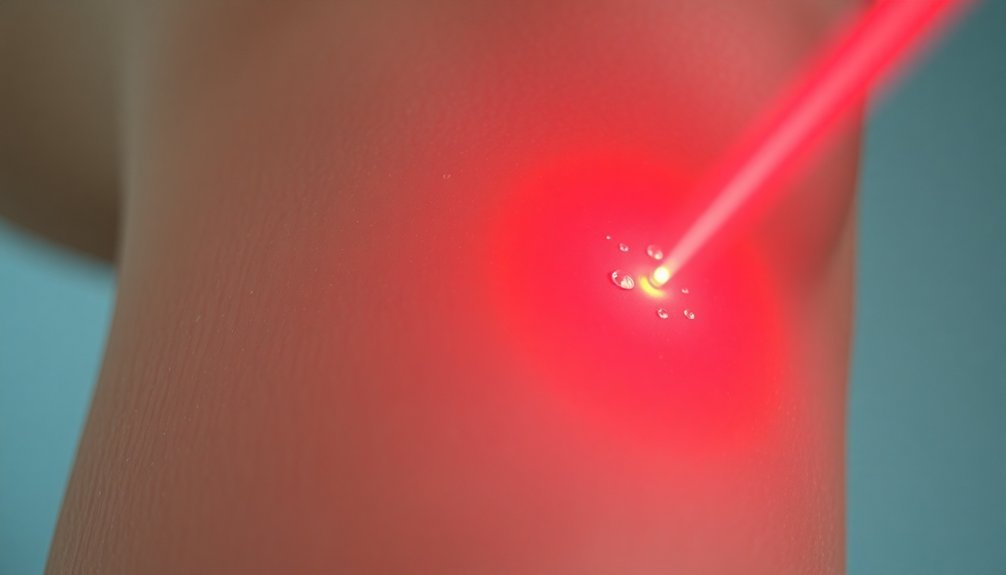
The treatment's effectiveness comes from its ability to convert light energy into cellular energy.
As your cells absorb the laser's photons, they increase their production of ATP – your body's cellular fuel.
This boost in energy drives the healing process forward, stimulating intercellular activity and promoting tissue repair.
The therapy also uses special wavelengths of light that reduce inflammation levels to provide fast relief.
The Science Behind Light Treatment
When you receive laser therapy, specific wavelengths of light penetrate your tissues to stimulate cellular repair and regeneration at the molecular level.
Your cells respond to this light energy by increasing their energy production and activating healing mechanisms that reduce inflammation.
The therapeutic light also improves your blood circulation in the treated area, delivering more oxygen and nutrients to help repair damaged tissues and reduce pain. This non-invasive treatment provides healing benefits without cutting or burning the skin.
Light Stimulates Cell Repair
Through advanced photobiomodulation therapy, light penetrates deep into damaged tissue to jumpstart your body's natural healing processes. When therapeutic light reaches your cells, it stimulates your mitochondria to produce more ATP, which powers cellular repair and regeneration.
This activation triggers multiple healing pathways in your body, including the release of growth factors and the regulation of key cellular signals. Studies have shown that light therapy produces natural pain-killing endorphins to provide relief.
You'll experience faster healing because light therapy directly influences your cells to:
- Boost production of serotonin and acetylcholine, enhancing tissue regulation
- Increase ATP production, providing more energy for cellular repair
- Activate JAK/STAT and MAPK pathways essential for wound healing
- Stimulate growth of new, healthy cells while increasing oxygen flow
- Reduce inflammation and cell death in damaged areas
The process works remarkably well – studies show that over 70% of patients report significant pain reduction after treatment. Your body responds to the light therapy by increasing cellular metabolism and reducing oxidative stress.
As your cells receive this therapeutic boost, they work more efficiently to repair damaged tissue, decrease inflammation, and restore normal function to your joints.
Enhanced Blood Flow Effects
Light therapy kicks off a powerful chain reaction in your circulatory system, delivering essential nutrients and oxygen directly to painful joints. When the laser's energy penetrates your tissue, it triggers immediate vasodilation, expanding your blood vessels and markedly boosting circulation to the affected area.
The therapy's low-level light energy penetrates deep into painful joints without generating heat or causing damage. You'll experience multiple benefits from this enhanced blood flow. As circulation improves, your body can more effectively deliver anti-inflammatory cytokines and healing factors to the painful joint.
This increased blood flow also helps reduce swelling by stimulating your lymphatic system, which removes excess fluid and waste products from the affected tissues.
The improved circulation doesn't just temporarily ease your discomfort – it actively accelerates your body's natural healing processes. Your damaged tissues receive a surge of oxygen and nutrients they need to repair themselves, while the enhanced blood flow helps remove inflammatory substances that contribute to your pain.
Think of it as creating a healing highway: the laser opens up traffic lanes in your blood vessels, allowing your body's repair teams to reach the injury site faster and work more efficiently. This enhanced circulation plays a vital role in both immediate pain relief and long-term joint healing.
Healing at Cellular Level
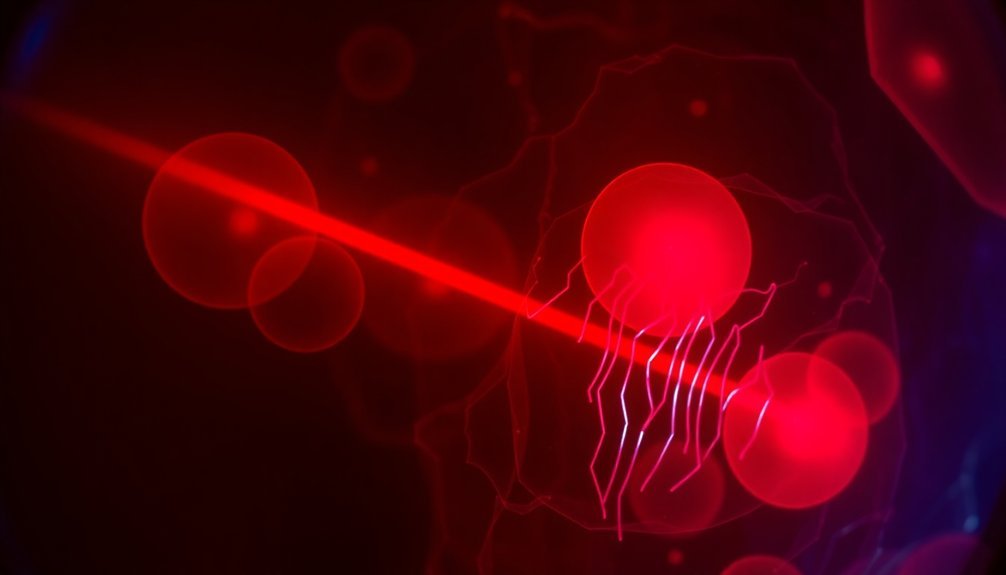
Your body's cells naturally repair and renew themselves when exposed to therapeutic laser light, which triggers increased ATP production for enhanced cellular energy.
The laser treatment's specific wavelengths boost blood circulation to damaged areas, delivering essential oxygen and nutrients where they're needed most.
This combination of cellular stimulation and improved blood flow creates ideal conditions for your joints to heal and recover from pain and inflammation. The healing process is further enhanced by endorphin release, providing natural pain relief.
Cells Repair and Renew
Deep within the body's tissues, laser therapy sets off a remarkable chain of cellular repair mechanisms. When the laser energy penetrates your joints, it triggers essential biochemical reactions that boost your natural healing processes.
You'll experience increased blood flow as your arteries and veins dilate, delivering essential oxygen and nutrients to damaged areas. Treatment sessions are typically brief and efficient, lasting just 2-10 minutes.
The therapy enhances your cellular metabolism and stimulates collagen production, which is important for repairing damaged tissues. Your white blood cells become more active, accelerating the healing process while removing injured cellular waste.
What's more, the treatment naturally releases endorphins, your body's own painkillers, while modulating your immune response to reduce inflammation.
- Stimulates tissue regeneration and cellular repair through enhanced ATP production
- Increases stem cell activation to improve recovery time
- Boosts collagen synthesis for stronger tissue repair
- Enhances blood circulation for better oxygen and nutrient delivery
- Activates natural pain-relieving mechanisms through endorphin release
Clinical studies show that over 70% of patients report significant pain reduction after laser therapy sessions. The treatment's ability to work at the cellular level makes it particularly effective for managing joint pain and improving mobility without invasive procedures.
Light Stimulates ATP Production
At the core of laser therapy's healing power lies its remarkable ability to boost ATP production in your cells. When specific wavelengths of laser light penetrate your tissues, they target cytochrome C oxidase in your cells' mitochondria, stimulating the production of ATP – your body's cellular energy currency.
This process, known as photobiomodulation (PBM), works by restoring cellular respiration in damaged cells. As photons from the laser light are absorbed by your mitochondria, they trigger increased ATP synthesis, which provides the energy needed for cellular repair and healing. The therapy effectively displaces nitrous oxide, allowing oxygen to properly fuel cellular processes.
You'll experience reduced inflammation and pain as your cells receive this energy boost.
The increased ATP production doesn't just reduce pain – it actively promotes healing in your affected joints. Your damaged tissues begin to repair themselves more efficiently, and you'll notice improved range of motion and decreased stiffness.
The therapy also helps relax surrounding muscles, creating a thorough healing effect. With regular treatments, you can maintain these benefits and keep joint pain at bay.
Your cells' enhanced energy production through ATP continues to support tissue repair and reduce inflammation long after each treatment session.
Blood Flow Boosts Recovery
Through laser therapy's healing mechanisms, blood flow dramatically increases to the affected joint areas, creating an ideal environment for recovery. Your body's natural healing processes kick into high gear as improved circulation delivers oxygen and nutrients directly to damaged tissues. Low-level lasers help dilate blood vessels without generating heat or vibration.
When laser light penetrates your joints, it stimulates cellular activity and boosts mitochondrial energy production, helping your cells communicate better and accelerate tissue repair.
The anti-inflammatory effects of laser therapy provide immediate relief by reducing swelling and pressure on nerve endings. You'll experience faster healing and shorter recovery times, especially after surgery, without the need for invasive treatments or medications.
- Enhanced blood circulation brings essential oxygen and nutrients to injured areas
- Cellular regeneration accelerates as mitochondrial energy production increases
- Reduced inflammation leads to immediate pain relief
- Improved lymphatic drainage helps remove waste products
- Faster tissue repair through optimized healing conditions
As laser therapy targets the root cause of your joint pain, you'll notice lasting improvements. The treatment's ability to enhance blood flow while stimulating cellular repair creates a thorough healing response that promotes long-term recovery and helps prevent future complications.
Natural Pain Relief Benefits
Natural pain relief solutions stand out from conventional treatments by offering a thorough approach to managing discomfort. You'll find that these remedies work with your body's natural healing processes, providing relief without the risks associated with traditional medications.
Essential oils like eucalyptus, lavender, and peppermint deliver targeted relief through their anti-inflammatory and analgesic properties.
When you're seeking drug-free alternatives, herbal remedies can be particularly effective. Turmeric and ginger work as powerful anti-inflammatories, while willow bark offers aspirin-like benefits without synthetic ingredients. You're also getting more value for your money, as many natural solutions are more cost-effective than prescription medications.
You can enhance your pain management routine by incorporating therapeutic practices like mindfulness meditation and yoga. These techniques don't just mask pain – they help you develop long-term strategies for managing discomfort.
The beauty of natural approaches lies in their minimal side effects and non-invasive nature. Whether you're using clove oil for localized pain or practicing acupuncture for overall relief, you're choosing methods that support your body's innate healing abilities without creating dependency on pharmaceutical interventions.
Quick Recovery Time Explained
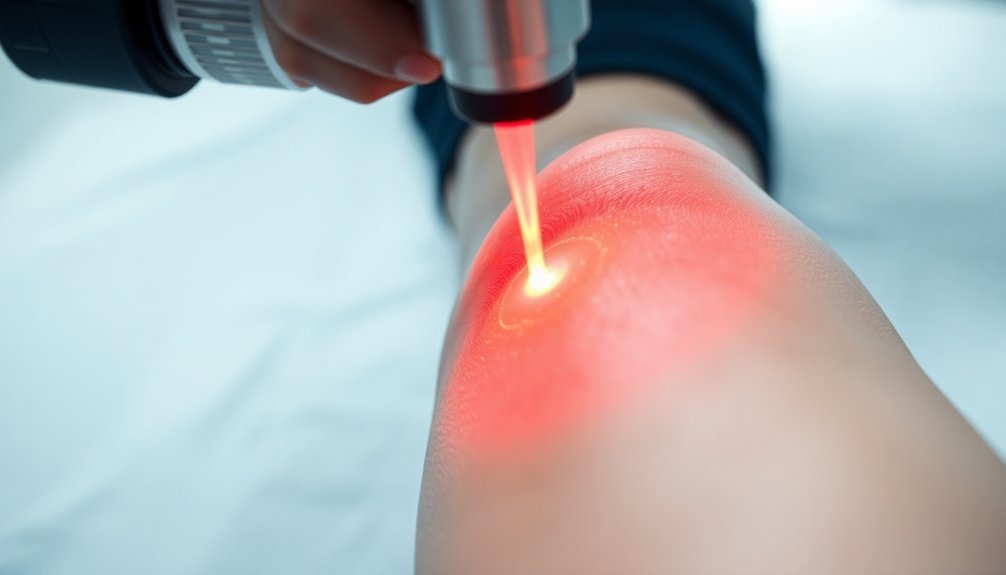
Your quick recovery from laser treatment starts at the cellular level, where the therapy stimulates cells to produce more energy and accelerate tissue repair.
The treatment's ability to improve blood flow to affected joints means you'll experience enhanced healing and reduced inflammation within 18-24 hours after each 5-10 minute session.
You'll typically notice significant improvements after just 3 to 5 short treatment sessions, making laser therapy an efficient option for managing joint pain.
Cellular Repair Process
When laser light penetrates joint tissue, it triggers a remarkable cascade of cellular repair mechanisms that speed up healing and reduce recovery time. Your damaged cells respond by increasing their ATP production, which provides the energy needed for repair and regeneration.
Through photobiomodulation, the laser light helps displace nitrous oxide from your cells, boosting oxygen availability and reducing inflammation.
The cellular repair process works on multiple levels to ease your joint pain:
- Your cells become more active and efficient at repairing damaged tissue through enhanced biochemical responses
- Your immune system's response becomes more balanced, controlling inflammation while promoting healing
- Your body produces more endorphins naturally, providing you with immediate pain relief
- Your blood circulation improves, delivering essential nutrients to damaged areas faster
- Your joint tissue regenerates more effectively, leading to improved mobility
This cellular repair process explains why you'll notice improvements quickly. As your cells repair themselves more efficiently, you'll experience reduced inflammation, better joint function, and decreased pain levels. The process continues even after your treatment session ends, as the stimulated cells maintain their enhanced repair activities for several hours.
Improved Blood Flow Impact
Laser therapy kicks off a powerful boost in blood circulation that revolutionizes joint pain recovery. When the laser penetrates your tissues, it triggers an immediate increase in blood flow, delivering essential oxygen and nutrients directly to your affected joints.
This enhanced circulation doesn't just temporarily relieve pain – it actively promotes healing by removing inflammatory substances and metabolic waste from the damaged area.
You'll experience faster recovery because improved blood flow accelerates tissue repair through multiple mechanisms. The laser stimulates photobiomodulation, which enhances your cellular repair processes and modulates your immune response. It also increases the production of anti-inflammatory cytokines while facilitating the release of endorphins, your body's natural painkillers.
Clinical evidence strongly supports these benefits, with over 70% of patients reporting significant pain reduction. Your improved circulation helps reduce edema and decrease nerve sensitivity by reducing bradykinin levels.
The CDC now recommends laser therapy for various types of pain management, and it's easy to see why – 93% of patients are satisfied enough to return for additional treatments. This enhanced blood flow creates a thorough healing environment that addresses both immediate pain relief and long-term joint health.
Reduced Treatment Sessions Needed
Most patients appreciate that deep tissue laser therapy requires remarkably few sessions to achieve lasting relief from joint pain. You'll typically need just 3-5 treatments to experience noticeable improvements, with each session lasting only 5-10 minutes.
The therapy's effectiveness stems from its ability to stimulate cellular activity and trigger powerful anti-inflammatory responses at the deepest tissue levels.
- Sessions provide immediate relief that continues for 18-24 hours after treatment
- No surgery or downtime required, allowing you to resume activities right away
- Increased ATP production speeds up your body's natural healing process
- Clinical studies show 97% of patients experience significant pain relief
- Treatment plans are customized to your specific condition and needs
Your body continues benefiting from the laser therapy long after each session ends. The treatment's deep penetration helps reduce inflammation at the cellular level while boosting tissue repair and metabolism.
You won't need to worry about negative side effects, and it's an excellent alternative to pain medications. The quick sessions and proven results make laser therapy an efficient solution for various joint conditions, from arthritis to sports injuries, even helping with post-surgical recovery.
Treating Different Joint Conditions
Designed to address multiple joint-related conditions, laser therapy offers targeted treatment options for various musculoskeletal problems. Whether you're dealing with osteoarthritis's cartilage breakdown or rheumatoid arthritis's autoimmune inflammation, laser treatment can effectively manage your joint pain through its specialized healing mechanisms.
If you're suffering from gout, the laser's ability to trigger biological responses helps reduce inflammation caused by uric acid crystals. For tendinitis and bursitis patients, the therapy's tissue repair capabilities promote healing in inflamed tendons and bursae, while simultaneously increasing cellular energy production through enhanced ATP synthesis.
You'll find that laser therapy's versatility extends across different joint conditions thanks to its multiple therapeutic actions. The treatment stimulates your body's natural healing processes by improving oxygen availability and promoting tissue repair.
With a proven 70% success rate and endorsement from the American Academy of Orthopedic Surgeons, you can trust this treatment approach for various joint issues. Since it's non-invasive and free from significant side effects, you won't need to worry about recovery time or complications, regardless of your specific joint condition.
Blood Flow and Inflammation
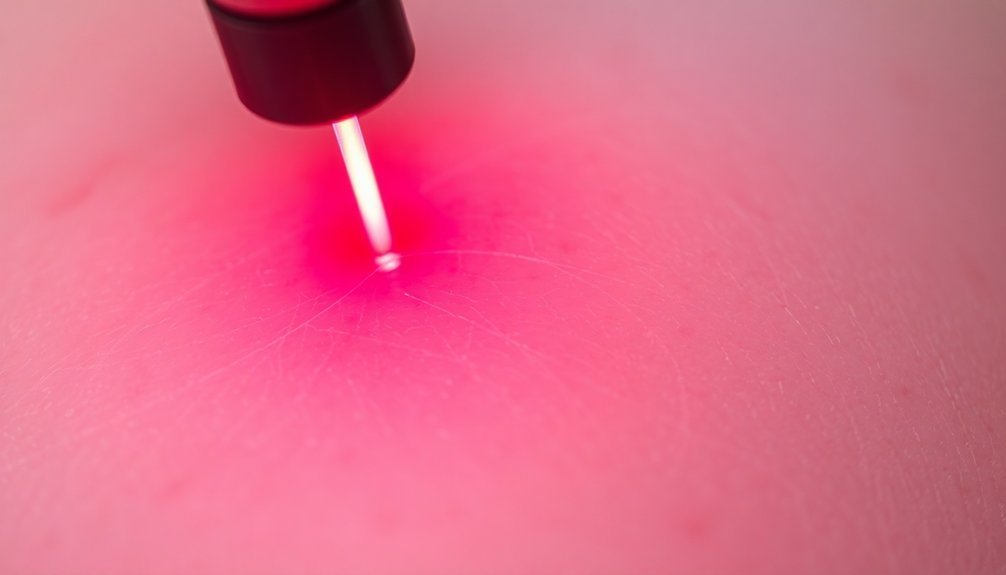
Through its advanced therapeutic mechanisms, laser treatment substantially improves blood flow and reduces inflammation in affected joints. When you receive laser therapy, the light energy penetrates your tissue and triggers increased circulation, delivering more oxygen and nutrients to the damaged area.
This enhanced blood flow activates your body's natural healing processes while simultaneously reducing inflammation through improved lymphatic drainage.
- Boosts cellular energy production through increased oxygen delivery
- Stimulates the release of anti-inflammatory substances in your joints
- Reduces swelling by improving lymphatic drainage and decreasing edema
- Enhances the delivery of healing nutrients to damaged tissues
- Activates mitochondria to speed up cellular repair processes
The therapy's dual action on blood flow and inflammation creates a powerful healing environment in your joints. As inflammation decreases, pressure on nerve endings diminishes, leading to rapid pain relief.
You'll experience improved joint function as the enhanced circulation continues to support tissue repair and regeneration. The treatment's ability to trigger beneficial biochemical reactions means you're getting natural, non-invasive relief that works at the cellular level to promote lasting healing effects.
Long Term Pain Management Results
Building on these immediate healing effects, laser therapy offers remarkable long-term pain management results that extend well beyond the treatment period. You'll experience peak pain relief around 2-4 weeks after completing therapy, with benefits lasting up to 12 weeks. Multiple studies confirm that patients consistently report significant improvements in both pain levels and mobility.
| Timeline | Benefits | Clinical Evidence |
|---|---|---|
| 2-4 Weeks | Peak Pain Relief | 22 trials confirm consistent reduction |
| Up to 12 Weeks | Sustained Benefits | No adverse effects reported |
| Long-Term | Improved Function | Significant disability reduction |
When you follow recommended treatment protocols, you'll likely notice lasting improvements in your joint function and daily activities. The therapy's effectiveness stems from its ability to trigger lasting biochemical changes in your body, including reduced inflammation through lower bradykinin levels and increased endorphin release. You'll benefit from enhanced tissue repair and improved blood circulation, which continue to support joint health long after treatment ends. Research shows that these improvements aren't just temporary – many patients report sustained relief after just a few sessions, potentially reducing their need for more invasive treatments.
Beyond Traditional Pain Treatments
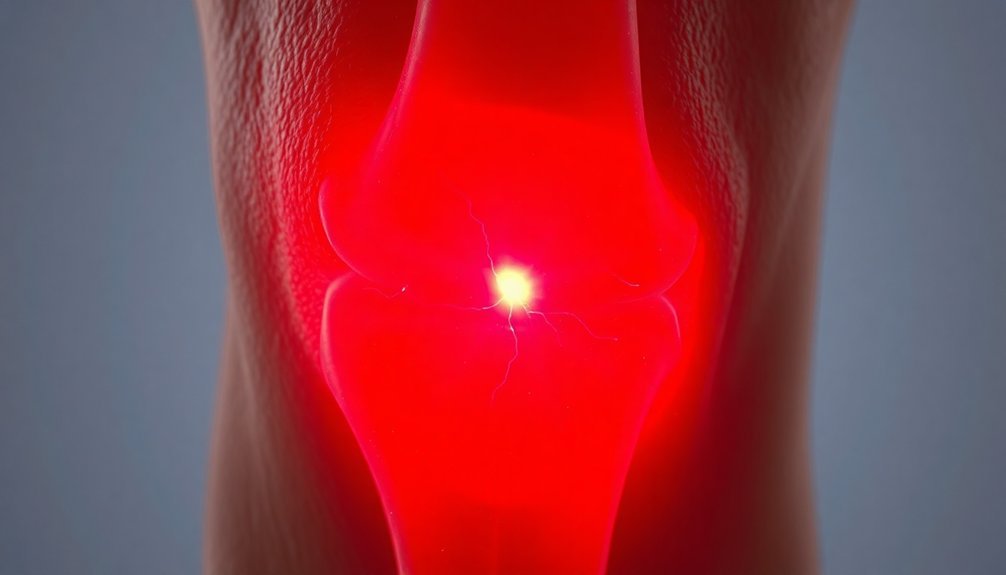
Laser therapy stands apart from conventional pain treatments by offering a powerful combination of cellular stimulation and natural healing. When specific wavelengths of light penetrate your joints, they trigger biochemical responses that reduce inflammation and promote healing.
You'll experience increased blood circulation, which delivers essential nutrients to affected areas, while the therapy naturally decreases bradykinin levels to reduce nerve sensitivity.
- Non-invasive and drug-free approach with no side effects
- Quick 5-10 minute treatments that fit your busy schedule
- Clinically proven with 97% patient satisfaction rate
- Endorsed by the American Academy of Orthopedic Surgeons
- Treats multiple conditions from arthritis to surgical recovery
What makes laser therapy particularly effective is its ability to stimulate your body's natural healing mechanisms. Your cells respond to the specific wavelengths by accelerating repair processes, while the treatment simultaneously triggers the release of endorphins for natural pain relief.
Whether you're dealing with arthritis, soft-tissue injuries, or post-surgical recovery, laser therapy provides a thorough solution. You'll benefit from both immediate pain relief and long-term healing, making it an increasingly popular choice for those seeking alternatives to traditional pain management methods.
Safety and Clinical Evidence
According to extensive clinical research and meta-analyses, low-level laser therapy (LLLT) demonstrates both remarkable safety and proven effectiveness for joint pain treatment. You'll find it's particularly effective for knee osteoarthritis, where studies show significant pain reduction of up to 14.23mm on the Visual Analog Scale immediately after treatment, with benefits peaking at 31.87mm reduction 2-4 weeks post-therapy.
What makes LLLT especially appealing is its excellent safety profile. You won't experience serious side effects, unlike with opioids or other pain medications. The treatment can reduce your pain by up to 49% without requiring additional interventions.
Research confirms its effectiveness for various conditions – from knee osteoarthritis to neck pain, carpal tunnel syndrome, and fibromyalgia.
When you follow the World Association for Laser Therapy's recommended dosing guidelines, you'll likely experience ideal results. The therapy works by targeting Cytochrome C Oxidase in your cells, boosting ATP production and reducing inflammation.
It's a non-invasive option that doesn't require recovery time, and you can use it as a standalone treatment or alongside other therapies to manage your joint pain effectively.
Frequently Asked Questions
How Many Laser Therapy Sessions Are Typically Needed for Effective Pain Relief?
You'll need 4-6 sessions for acute conditions and 6-12+ sessions for chronic issues. Your exact treatment plan depends on your injury's severity, healing rate, and response to therapy. Sessions last 5-10 minutes.
Can Laser Therapy Be Combined With Other Pain Management Treatments?
Yes, you can safely combine laser therapy with other treatments like physical therapy and medications. It's highly effective when integrated into a multimodal pain management plan, enhancing overall results without causing adverse interactions.
Is Laser Treatment Covered by Most Health Insurance Plans?
You'll find that laser treatment isn't covered by most health insurance plans. While some insurers cover it for specific conditions, you'll need pre-approval, and coverage varies widely among providers and individual plans.
What Should Patients Avoid Before and After Laser Therapy Sessions?
Before sessions, you'll need to avoid lotions, certain medications, and dehydration. After treatment, don't expose treated areas to direct sunlight, skip strenuous activities, and avoid using any skin products without approval.
Does Laser Therapy Work Equally Well for All Age Groups?
You'll find laser therapy is equally effective across all age groups. It's safe and shows consistent results whether you're young or elderly, with no significant differences in pain reduction or healing outcomes reported.
In Summary
Laser therapy's proven pain relief benefits mean you're getting an effective, non-invasive treatment option. You'll experience faster healing as the light energy penetrates deep into your tissues, boosting cellular repair and blood flow while reducing inflammation. Whether you're dealing with acute or chronic joint pain, you can count on this safe, clinically-backed treatment to provide both immediate relief and long-term healing benefits.





Leave a Reply